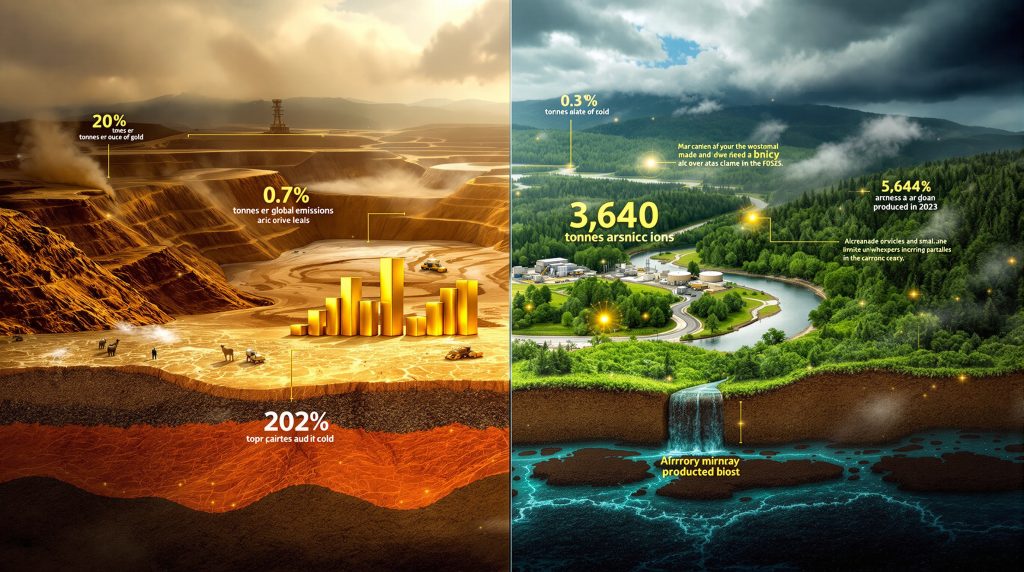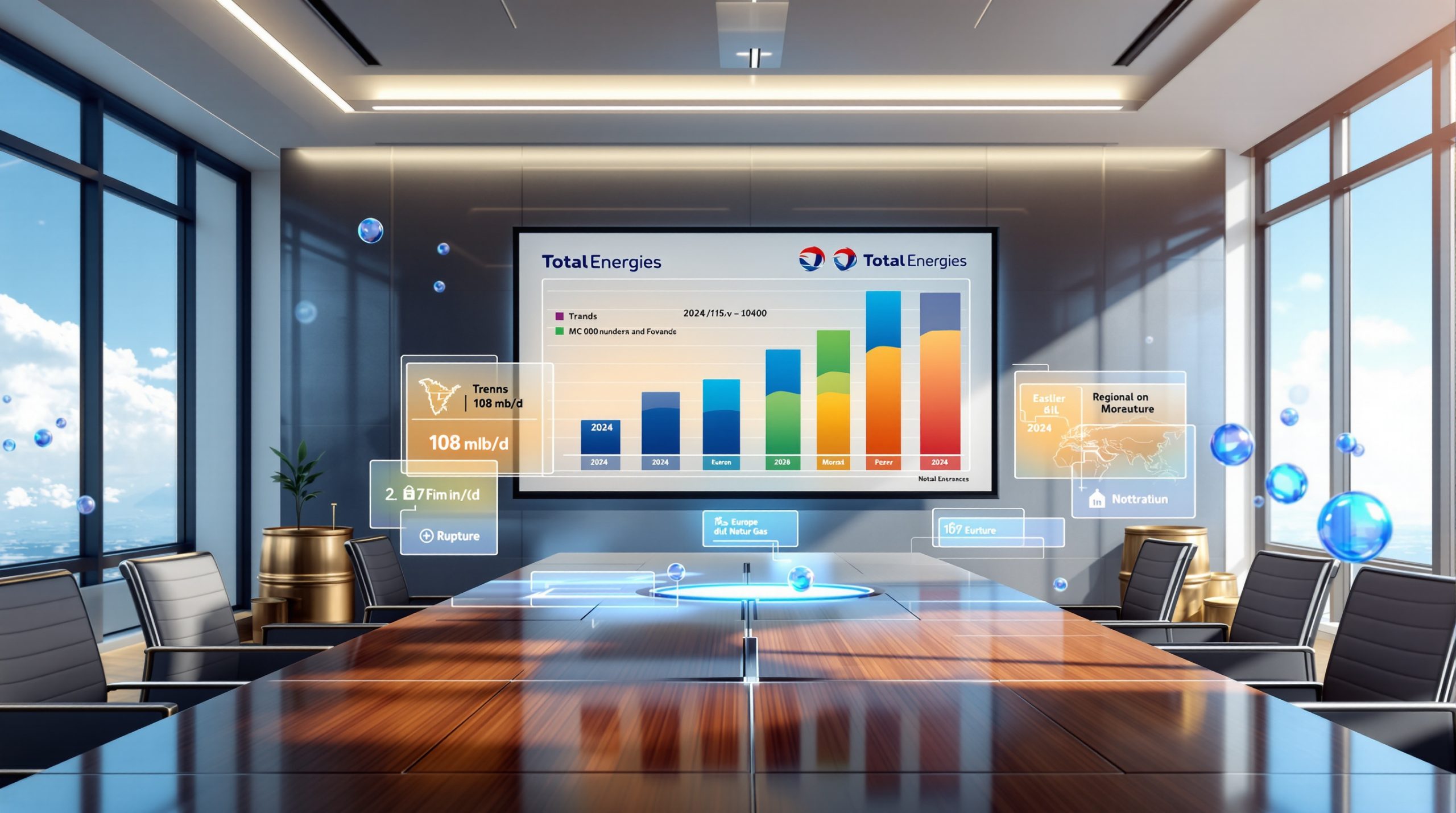Gold mining environmental impact represents one of the most significant challenges facing the extractive industries today, with consequences that extend far beyond immediate mining sites. The sector's environmental burden stems from fundamental geological realities: gold occurs in extremely low concentrations within ore deposits, typically ranging from 0.5 to 10 grams per tonne. This necessitates moving massive quantities of earth and employing chemical-intensive processing methods to extract economically viable amounts of precious metal.
Contemporary gold operations generate approximately 20 tonnes of waste material for every ounce of gold produced, creating permanent landscape alterations that persist for centuries. Furthermore, the industry's environmental footprint encompasses water contamination, ecosystem destruction, air quality degradation, and long-term soil impacts that collectively represent a significant challenge for sustainable mining transformation.
Global gold production has stabilised around 3,600 tonnes annually, with mining operations spanning diverse ecosystems from tropical rainforests to arid desert regions. Each extraction site creates unique environmental pressures based on local geology, climate conditions, and existing ecological vulnerabilities.
Water Contamination: The Most Persistent Mining Legacy
Acid Mine Drainage and Long-Term Water Quality Impact
Acid mine drainage stands as perhaps the most enduring environmental consequence of gold mining operations. When mining exposes sulfide-bearing minerals like pyrite to oxygen and water, chemical reactions produce sulfuric acid that can contaminate water systems for hundreds of years. This acidic runoff mobilises heavy metals naturally present in rock formations, creating toxic combinations that devastate aquatic ecosystems across vast geographic areas.
The chemical process underlying acid mine drainage involves the oxidation of iron sulfide minerals according to the reaction: 2FeS₂ + 7O₂ + 2H₂O → 2FeSO₄ + 2H₂SO₄. The resulting acidic conditions, typically producing pH levels between 2 and 4, dissolve metals including iron, copper, zinc, and aluminium from surrounding rock matrices.
Historical mining sites across California, Montana, and Wales continue producing acidic drainage decades after operations ceased, demonstrating the persistent nature of this contamination. Treatment costs for legacy acid mine drainage often exceed millions of dollars annually, representing ongoing environmental liabilities that extend far beyond operational timeframes.
Chemical Processing Contamination Pathways
Modern gold extraction relies heavily on chemical agents that present both immediate and long-term environmental risks. Cyanide heap leaching, employed at approximately 60% of global gold operations, involves applying sodium cyanide solutions to ore piles to dissolve gold particles. While effective for gold recovery, cyanide's extreme toxicity creates significant contamination potential through accidental releases or inadequate containment.
Mercury contamination, though largely phased out from industrial operations in developed nations, remains prevalent in artisanal gold mining sectors. According to environmental impacts of gold mining assessments, mercury releases contribute to both local and global contamination cycles. Mercury's volatility at processing temperatures enables atmospheric transport across thousands of kilometres, contributing to contamination in remote ecosystems far from mining sites.
The persistence of mercury in environmental systems creates bioaccumulation pathways through aquatic food webs. Fish tissue concentrations can reach 1,000 to 100,000 times the mercury levels present in surrounding water, depending on species characteristics and ecosystem conditions.
Heavy Metal Mobilisation and Ecosystem Infiltration
Mining operations expose previously buried geological formations containing naturally occurring heavy metals including arsenic, lead, cadmium, and copper. The disruption of these formations through excavation and processing mobilises these metals into water systems, where they persist in sediments and bioaccumulate through food chains.
Heavy Metal Contamination Profile in Gold Mining
| Metal | Primary Source | Environmental Pathway | Health Impact Duration |
|---|---|---|---|
| Arsenic | Sulfide ore processing | Groundwater infiltration | Decades to centuries |
| Lead | Ore extraction waste | Surface water runoff | 20-100 years |
| Cadmium | Rock excavation | Soil and sediment accumulation | 50-200 years |
| Mercury | Amalgamation processes | Atmospheric and aquatic transport | Permanent environmental cycling |
Heavy metal speciation determines environmental behaviour and bioavailability. Arsenic speciation affects whether contamination remains in solution or becomes absorbed by sediments. Lead and cadmium form complexes with organic matter that influence their mobility through groundwater systems. Mercury methylation in oxygen-depleted sediments converts relatively inert inorganic mercury into highly bioavailable methylmercury.
Ecosystem Destruction and Biodiversity Loss
Deforestation and Habitat Fragmentation Dynamics
Large-scale gold mining requires extensive land clearing that eliminates entire ecosystem structures. Open-pit operations can span multiple square kilometres, while supporting infrastructure including waste storage facilities, processing plants, and transportation networks multiply the total environmental footprint by factors of five to ten times the pit area itself.
Modern mining industry innovation acknowledges that understanding mining's environmental impact requires recognition of complex interactions: negative impacts often stem from combinations of mining activities, historical land use patterns, and other regional stressors. This complexity underscores how ecosystem destruction results from multiple overlapping pressures rather than mining alone.
Forest removal eliminates carbon sequestration capacity ranging from 30-100 tonnes per hectare in temperate regions to 100-400 tonnes per hectare in tropical ecosystems. The loss of vegetation cover triggers cascading effects including disrupted water cycles, increased soil erosion, and elimination of wildlife corridors essential for species movement and genetic diversity maintenance.
Species Displacement and Population Dynamics
Mining operations create landscape discontinuities that fragment habitats into isolated patches incapable of supporting viable wildlife populations. Species requiring large territorial ranges or specialised habitat conditions face local extinction risks, while noise, dust, and chemical contamination from mining activities create zones of ecological disruption extending well beyond immediate mining boundaries.
However, comprehensive assessment frameworks reveal nuanced impacts: approximately 71% of assessed industrial mines fall into "Moderately Low" to "Low" impact categories, suggesting formal gold mining operations may demonstrate less ecological harm than commonly perceived. Nevertheless, this finding excludes unregulated artisanal mining operations where impacts may prove more severe, though reliable data remains extremely limited.
Among the 16 sites rated as having "Very High" ecological impact, most occur in ecologically significant regions that had already experienced degradation from multiple sources. This pattern highlights how mining impacts often compound existing environmental stresses rather than creating entirely new forms of ecosystem destruction.
Biodiversity Recovery Timeline Analysis:
- Pioneer species recolonisation: 2-5 years
- Intermediate successional establishment: 10-25 years
- Mature ecosystem structure development: 25-50 years
- Climax community composition restoration: 50+ years
Recovery trajectories vary substantially based on ecosystem type, with tropical rainforest restoration requiring 50+ years while grassland ecosystems may recover within 10-20 years under favourable conditions.
Air Quality Impacts and Atmospheric Contamination
Particulate Matter Generation and Transport
Gold mining operations generate substantial airborne particulates through blasting, excavation, material transportation, and ore processing activities. These dust clouds contain not only inert rock particles but also potentially toxic minerals and chemical residues from processing operations.
Particulate matter concentrations frequently exceed World Health Organisation air quality guidelines within 15-20 kilometre radii of active mining sites. PM2.5 and PM10 particles can remain suspended in atmospheric conditions for extended periods, affecting respiratory health in surrounding communities and reducing agricultural productivity through dust deposition on crop surfaces.
The composition of mining-generated dust varies significantly based on local geology and processing methods employed. Silica-rich dusts create pneumoconiosis risks for occupational exposure, whilst dusts containing heavy metal residues present additional toxicity concerns for both human health and ecosystem contamination.
Mercury Emissions and Global Transport Cycles
Gold mining represents the largest single anthropogenic source of atmospheric mercury emissions globally. Mercury released during processing becomes airborne and participates in global transport cycles, depositing in ecosystems thousands of kilometres from emission sources.
This atmospheric mercury transport contributes to contamination of fish populations in remote lakes and rivers, bioaccumulation in Arctic food webs, and elevated mercury exposure among indigenous communities dependent on traditional food sources. Global background mercury levels in precipitation reflect cumulative contributions from mining operations worldwide.
The conversion of atmospheric mercury to methylmercury in aquatic sediments creates bioaccumulation pathways that concentrate mercury through food webs, ultimately affecting top predators and human populations consuming contaminated fish and wildlife.
Mining Waste Generation and Long-Term Management
Tailings and Waste Rock Storage Requirements
Gold mining generates enormous waste volumes, with average waste-to-gold ratios approaching 1,000,000:1 by weight. Global tailings production exceeds 14 billion tonnes annually, requiring permanent storage facilities that represent lasting landscape alterations.
Tailings storage facilities contain concentrated levels of processing chemicals and mobilised heavy metals, creating long-term environmental risk sources. These facilities require ongoing monitoring and maintenance spanning 100+ years, with major tailings dam failures occurring every 2-3 years globally according to industry safety assessments.
The engineering challenges associated with tailings storage include:
- Structural stability under varying climate conditions
- Prevention of seepage into groundwater systems
- Management of chemical reactions within stored materials
- Long-term financial assurance for perpetual monitoring
Perpetual Care and Financial Liabilities
Mining waste facilities require indefinite monitoring and maintenance long after mining operations cease. Climate change impacts on facility stability, groundwater monitoring requirements spanning decades, and community health surveillance needs represent hidden environmental burdens extending across multiple generations.
The costs associated with perpetual care often exceed original mining operation revenues, creating financial liabilities that transfer to public agencies when mining companies cease operations. This transfer of long-term environmental responsibility represents a significant externalisation of mining's true environmental costs.
Soil Degradation and Agricultural Impact
Topsoil Elimination and Ecosystem Foundation Loss
Gold mining operations strip away topsoil layers that required thousands of years to develop through weathering and organic matter accumulation processes. This removal destroys soil structure, eliminates beneficial microorganisms, and disperses organic matter that cannot be easily replaced through restoration efforts.
The destruction of soil A-horizon layers across mining areas eliminates the foundation for terrestrial ecosystem recovery. Mycorrhizal networks supporting plant communities are completely destroyed, whilst soil carbon storage capacity is permanently lost unless intensive restoration efforts rebuild soil organic matter content over decades.
Soil compaction from heavy mining equipment reduces water infiltration and retention capacity across areas extending beyond direct mining operations. This compaction affects hydrological patterns and reduces the land's capacity to support vegetation recovery even after mining activities cease.
Chemical Contamination of Agricultural Systems
Chemical residues from gold processing operations contaminate agricultural soils through multiple pathways including airborne deposition, surface water irrigation, and groundwater infiltration. These contaminants reduce crop yields, affect food safety standards, and can render agricultural land unsuitable for production.
Heavy metal accumulation in agricultural soils creates long-term food security risks for communities dependent on local agricultural production. Arsenic, cadmium, and lead concentrations in contaminated soils can exceed safe levels for crop production, whilst bioaccumulation in food crops creates human exposure pathways.
Human Health Consequences and Community Impact
Water Security and Community Health Effects
Communities located near gold mining operations frequently experience water scarcity and quality degradation affecting basic human needs. Contamination of local water sources forces communities to seek alternative supplies often at significant economic and social costs.
Documented community health impacts include:
- Increased rates of gastrointestinal illness from contaminated water exposure
- Skin conditions resulting from contact with contaminated water sources
- Respiratory problems from dust and chemical exposure
- Neurological effects from heavy metal contamination pathways
Ecosystem services like water purification, pollination, and climate regulation support nearly half of global GDP. The disruption of these services through mining activities creates economic impacts extending far beyond immediate mining employment benefits.
Food Security and Contamination Pathways
Heavy metals and chemical residues enter local food systems through contaminated irrigation water, bioaccumulation in fish and wildlife, and direct contamination of agricultural products. These pathways create ongoing health risks for communities dependent on local food sources.
Mercury bioaccumulation in fish tissue creates particular risks for communities relying on aquatic protein sources. Methylmercury concentrations in fish from mining-affected watersheds can exceed safe consumption guidelines, requiring dietary modifications and alternative protein sources.
Environmental Management and Mitigation Approaches
Contemporary Environmental Management Systems
Modern gold mining operations increasingly employ comprehensive environmental management frameworks designed to minimise ecological impacts. These approaches include pre-mining environmental assessments, real-time monitoring systems, and progressive rehabilitation programmes that restore ecosystems during and after mining operations.
In addition, contemporary modern mine planning indicates that many mining companies are implementing substantial ecosystem mitigation measures. These include land rehabilitation programmes, species protection initiatives, and ecosystem service enhancement projects often undertaken in collaboration with surrounding communities to mutual benefit of mining operations and local populations.
Advanced Environmental Technologies:
- Closed-loop water systems reducing contamination discharge
- Dry stack tailings storage eliminating dam failure risks
- Bioremediation programmes accelerating ecosystem recovery
- Renewable energy integration reducing operational carbon footprints
Regulatory Frameworks and Enforcement Mechanisms
Environmental protection in gold mining environmental impact mitigation depends heavily on robust regulatory frameworks and consistent enforcement mechanisms. Countries with strong environmental governance typically demonstrate superior mining industry environmental performance, whilst regions with weak regulatory oversight experience more severe environmental degradation.
Effective regulatory approaches incorporate:
- Mandatory pre-approval environmental impact assessments
- Financial bonding requirements for site remediation assurance
- Independent environmental monitoring throughout operational phases
- Community consultation and consent processes for project approval
The alignment with frameworks like the Kunming-Montreal Global Biodiversity Framework and guidance from the Taskforce on Nature-related Financial Disclosures (TNFD) provides standardised approaches for assessing and comparing environmental impacts across different mining operations and jurisdictions.
Future Perspectives and Industry Transformation
Technological Innovation for Impact Reduction
Emerging technologies offer potential pathways for substantially reducing the gold mining environmental impact. Innovations in ore processing, waste management, and ecosystem restoration could significantly improve industry environmental performance over coming decades.
For instance, AI in drilling technology presents promising technological developments that include:
- Biotechnology-based extraction methods reducing chemical usage
- Advanced materials for improved tailings containment systems
- Precision mining techniques minimising waste generation volumes
- Accelerated ecosystem restoration technologies
Industry Sustainability Transformation
The gold mining industry faces increasing pressure from investors, regulators, and communities to demonstrate measurable environmental responsibility. This pressure drives industry-wide adoption of sustainability frameworks and environmental performance standards that could reshape traditional mining practices.
However, sustainable gold mining practices strategic shifts from climate-focused work to broader environmental perspectives reflect this transformation. Comprehensive assessments of 122 mines across 30+ countries using standardised methodologies represent efforts to quantify nature-related risks and align with biodiversity protection frameworks.
Critical Considerations for Future Development:
Environmental Impact Duration: Mining impacts persist for centuries through acid mine drainage continuing 100-500 years, heavy metal contamination remaining active for decades, and ecosystem recovery requiring 25-50 years with intensive restoration efforts.
Comparative Environmental Assessment: Open-pit mining generally causes the most extensive environmental damage due to large-scale land disturbance, whilst artisanal mercury-based extraction creates the most toxic contamination per unit of gold produced.
Sustainability Potential: While mining inherently involves environmental disturbance, modern operations can minimise impacts through advanced technologies, comprehensive environmental management, and effective site restoration. Furthermore, mine reclamation innovation requires balancing extraction activities with ecosystem protection and community benefit delivery.
Industry Context: Gold mining typically demonstrates higher environmental impacts per unit value due to extremely low ore grades requiring massive earth movement. However, coal mining generally produces larger absolute environmental impacts due to operational scale and combustion-related emissions.
This analysis is based on current industry data and environmental assessments. Future technological developments and regulatory changes may alter the environmental impact profile of gold mining operations. Readers seeking specific investment or environmental decision-making guidance should consult current peer-reviewed research and regional regulatory requirements.
Are You Looking to Invest in Gold Miners with Strong Environmental Track Records?
Understanding gold mining's environmental challenges highlights why investors need real-time insights into ASX mining companies implementing sustainable practices. Discovery Alert's proprietary Discovery IQ model provides instant notifications when gold discovery announcements demonstrate both significant resource potential and responsible environmental management approaches. Start your 30-day free trial today to identify mining investment opportunities that align with environmental sustainability standards whilst positioning yourself ahead of market movements.




